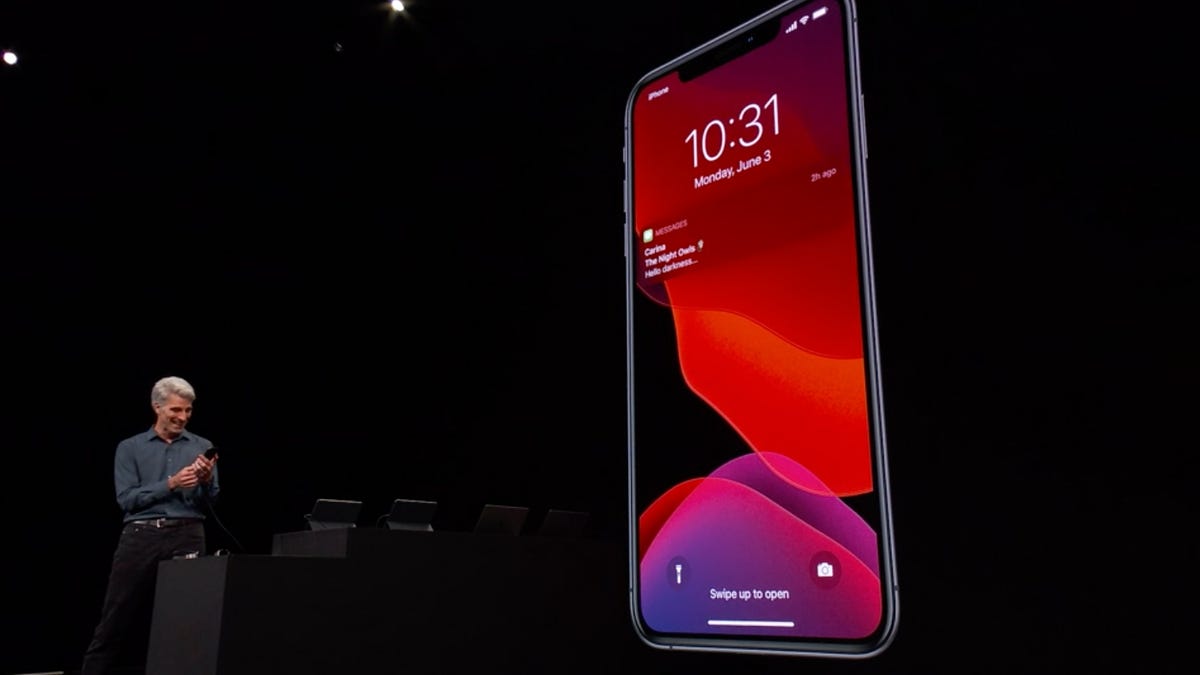Dark mode color scheme is coming to iPhones with iOS 13
Hello darkness, my new friend: iOS 13 will let you switch native Apple apps to a darkened color scheme that's easier on the eyes.

With iOS 13, native Apple apps and interfaces can ditch the white backgrounds in favor of black.
WWDC, Apple's annual developers conference, brought the usual slew of software announcements meant to power Apple's hardware through the new year. Among them: An alternative dark mode color scheme for devices running iOS 13, the newest version of Apple's operating system for iPhones. Enable it, and your phone will replace the light-colored interfaces in native Apple apps like Maps, Mail and Messages with a much darker design.
See also
- Apple iOS 13: New Siri voice, camera tools, Dark Mode for iPhone
- New Mac Pro makes its debut, starts at $5,999
- Apple gives the iPad its own OS
- Returning to Apple's WWDC after 20 years, now with 5 OSes instead of 1
- Get all the latest from WWDC
The long-rumored announcement didn't come as much of a surprise. Just last week, leaked screenshots showing off Apple's take on dark mode surfaced on 9to5Mac. It's also worth noting that Google introduced a similar feature for Android Q users at its I/O developer conference last month.
Apple's annual developer convention kicked off Monday at the McEnery Convention Center in San Jose, California (fittingly enough for fans of dark mode, the show's opening video featured the song "I Guess I Should Go to Sleep" by Jack White). The confab is in its 30th year, and it's the third year for Apple to hold its developer conference in San Jose. The city -- the third biggest in California and 10th largest in the US -- is about 50 miles south of San Francisco and only about 10 miles from Apple's headquarters in Cupertino.
WWDC is where Apple details its newest software and services that will arrive on devices later in the year. The company may be best known for its hardware, but the seamless integration of its hardware with its software is what sets Apple apart from rivals. Apple's ability to control every aspect of its products -- something that began when Steve Jobs and Steve Wozniak founded the company in 1976 -- has been key in making it the most powerful company in tech.
At the end of 2018, there were 1.4 billion Apple devices actively used around the globe, the company said in late January during its quarterly earnings report. More than 900 million of them were iPhones.
Meanwhile, Apple has more different operating systems than ever before. There's iOS for iPhones and iPads, MacOS for its computers, tvOS for Apple TV and watchOS for the Apple Watch. Then there's Apple Pay, iTunes, Apple Music, the App Store, iCloud, HomeKit and various other apps and services. It's critical that Apple make a strong impression at WWDC with the next versions of its software.
WWDC 2019: A quick visual recap of Apple's Worldwide Developers Conference keynote
See all photosAs of February 24, 83% of Apple's mobile devices on the market were running iOS 12, the company's mobile software from late 2018. Another 12% used iOS 11, and 5 percent of devices ran an older version, according to the company's developer dashboard. By comparison, only about 10% of Android devices ran Google's latest software, dubbed Pie, as of May 7
At the end of Apple's WWDC presentation last year, the company gave a sneak peak of Project Marzipan, its effort to make it easy to take apps developed for iOS devices to Macs. Its MacOS update released in September included four of Apple's own apps that originated on iOS -- News, Stocks, Voice Memos and Home..
CNET's Shara Tibken contributed to this story.

